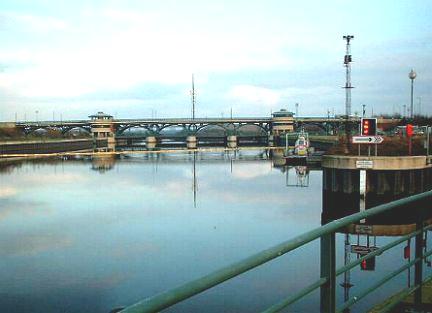
The River Tees is no stranger to major engineering projects. In 1810 and 1830 The Tees Navigation Company improved access to Stockton by means of the Mandale and Portrack Cuts respectively. The river had two huge horseshoe bends at these points – by cutting channels between “the ends of the horseshoes” the distance between Newport and Stockton was greatly reduced. (The narrow rivers you may have seen behind Teesside Retail Park and the former Dickens at Portrack are part of the former course of the river Tees).
In 1992 the biggest change to the river was started – the construction of the Tees Barrage. This is located to the west of Blue House Point just upstream of where the course of the old river comes in from Mandale. (If the barrage had been built further downstream the natural draining effect of the old river would have been lost and areas such as the nearby retail park and golf course would flood).
The Barrage was commissioned by the Teesside Development Corporation and the contractors were Tarmac Construction. In terms of cost (£50 million) and size it was Britain’s largest single engineering project. The premise was that that inward investment would be more likely to be attracted to a pleasant non tidal riverside environment than to a unpleasant tidal one. There would also be other benefits such as greatly improved conditions for all water sports and wildlife. The project included the building of an international standard canoe slalom/white water course and a navigation lock which enables vessels up to 6 metres wide to pass between the tidal and non tidal sections of the river. Together with drainage works which now intercept sewage before it goes in to the river the Barrage has totally transformed the upstream river corridor.
The river is clean, fish have returned and above all the investors have shown their confidence by coming in to transform the built environment and increase employment prospects. Certainly from a rowing perspective the river is now superb including as it does a 1000 metre multi lane multi purpose course. Well worth a visit – for road access follow the signs from the A66. Cyclists have a variety of routes including along both sides of the Barrage reach (east of the Princess of Wales Bridge) from either Stockton or Thornaby and from Middlesbrough via the riverside cycleway from Newport.
Boats using this reach should note that the rule of the road is, as on all other parts of the river, “keep right”. There are water skiing buoys to watch out for and, during the summer there may also be a ski jump moored toward the Teesdale bank. The Barrage Reach (that part of the river between the Barrage and the Princess of Wales Bridge) is subject to a shared use timetable agreed between high speed powered craft and other users. See Timetable in the Boathouse. If, when you wish to boat, the time slot is for users other than rowing craft please act as follows: Having put your boat on the water go upstream without delay and use that part of the river above The Princess of Wales Bridge. When returning to the Centre keep a good lookout for powered craft on the Barrage Reach, turn to come into the pontoon as soon as possible and take your boat off the water without delay. (The need for “no delay” is to avoid the possibility of your boat being caught by the wash of a powered craft and to avoid causing inconvenience to those rightfully using their time slot on this part of the river).
There is a 5 mph speed limit for powered craft using the river upstream of the Princess of Wales Bridge. The only exceptions (provided for in the River By Laws) are rescue and emergency craft and coaching craft accompanying paddle/oar powered boats. Please note the word “accompanying” – the exemption entitles coaches to accompany their crew at the pace at which the crew is travelling. It does not permit coaching launches to exceed the speed limit to simply get quickly from one part of the river to another when not with a crew. Please also remember that although there is a speed exemption when accompanying a crew, conditions may be encountered when a speed below the limit may nevertheless be appropriate.